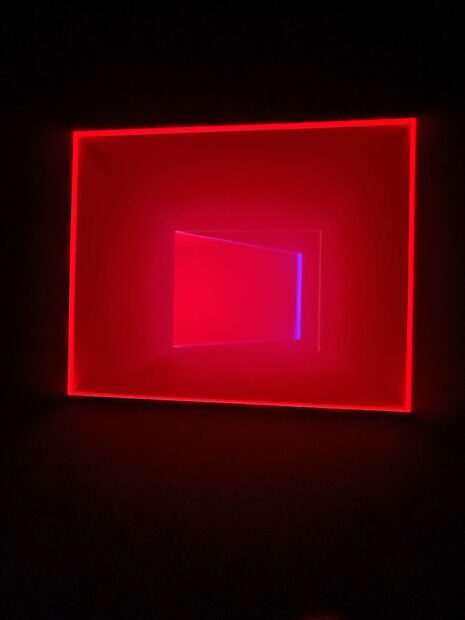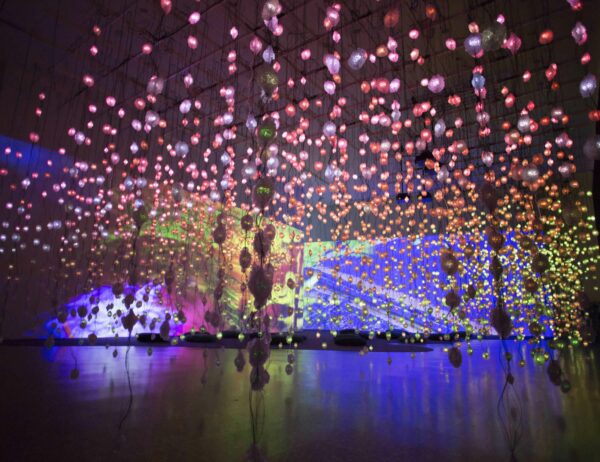
Installation view of “Pipilotti Rist: Pixel Forest and Worry Will Vanish,” the Museum of Fine Arts, Houston. © Pipilotti Rist / Photo: The Storyhive
Last month, I drove to Houston for the Glasstire Gala and had the opportunity to see a few exhibits, including the Pipilotti Rist installation at the Museum of Fine Arts, Houston (MFAH) and Evita Tezeno at Houston Museum of African American Culture.
I’ve followed Rist’s work for 26 years, since I first saw Ever Is Over All in 1997. The iconic video features a young woman who always reminds me of a badass version of Dorothy from Oz. She walks down the street swinging a large flower/club, breaking car windows, and a female police officer walks by and gives her a nod. Although Rist’s work has continued to evolve with more complicated visuals, this early piece shows the artist’s signature style, including hypnotic, trippy music, surreal imagery, and flower motifs combined with a strong female character.
In the early 2000s, Rist expanded into immersive installations. I remember seeing her 2008 piece Pour Your Body Out (7354 Cubic Meters) at the Museum of Modern Art in New York, for which she transformed the 110-foot-high walls of the atrium. Visitors were encouraged to lounge on large circular couches and talk. The work changed the museum environment from a white, sterile cube where nothing can be touched, to a place of comfort and intimacy.
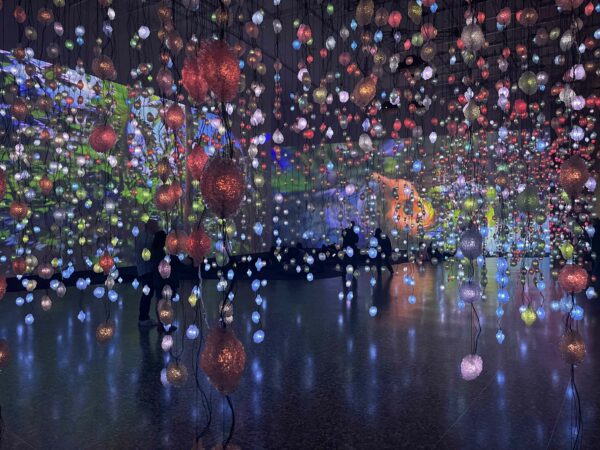
Installation view of “Pipilotti Rist: Pixel Forest and Worry Will Vanish,” the Museum of Fine Arts, Houston. Photo: Colette Copeland
The MFAH installation includes two works — Pixel Forest (2016) and Worry Will Vanish (2014). Pixel Forest contains 3,000 LED lights encased in cast resin organic spheres, which are suspended by wires from the ceiling. Visitors are encouraged to walk amongst the light forest, experiencing the rhythmic shifts in colors. The light orbs transform the architecture of the space, creating a magical and celestial world.
Worry Will Vanish is a two-channel video projected onto two walls. The colors of the lights sync in time to the colors in the video, thus coalescing the two works into one. The video takes us on a journey through myriad landscapes, including the flora and fauna of the natural/unnatural world, the interiors and exteriors of the human body, and the cosmos. I was especially captivated by the point of view of the camera as it moved through these spaces. As viewers, we become immersed inside Rist’s mind. Our perception shifts as the distinction between the real and virtual worlds blur — Rist’s work often ruminates upon the role of the human within the natural and technological. This work additionally speaks to the interconnectedness of all things natural and human.
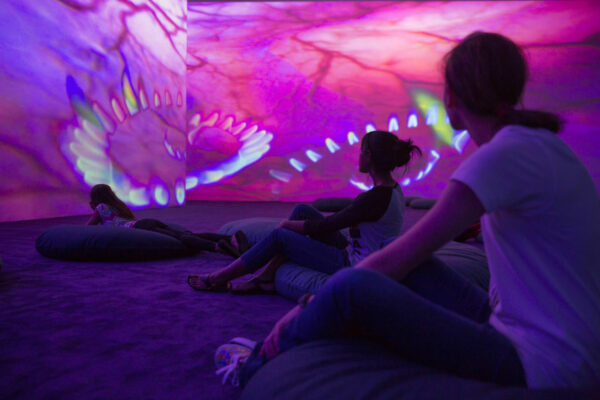
Installation view of “Pipilotti Rist: Pixel Forest and Worry Will Vanish,” the Museum of Fine Arts, Houston. © Pipilotti Rist / Photo: The Storyhive
Video and other time-based art can be tricky for both artists and curators, since visitors tend to walk by art with brief pauses. However, Rist is a master at creating comfortable and mesmerizing environments where visitors want to linger and watch the work in its entirety. The day I was there, all of the cushions were occupied and folks were lounging, often through more than one 10-minute video cycle.
Across the street, in the museum’s Kinder Building, are two other light-based installations, including a James Turrell and a Yayoi Kusama. I found it interesting to compare my experience of time in all three works. Turrell’s work, Caper, Salmon to White: Wedgework (2000) encourages contemplative meditation and patience. Visitors sit in a dark room and wait (sometimes ten minutes or more) for their eyes to adjust. Time slows and a proper viewing requires silence. In fact, I find that some of Turrell’s works — including this one — conjure a sacred space.
Like Turrell and Rist, Kusama uses light to transform her environments. I have visited many of her infinity rooms in different cities, and there is usually a one-minute time limit. I initially thought this was museums’ decision to accommodate large lines of people, but I learned it is part of Kusama’s mandate. The viewing platform inside Kusama’s work Aftermath of Obliteration of Eternity (2009) is short and narrow, with room to turn around. When inside one of her infinity rooms, I always feel that I am in a race with time to take it all in before my one-minute limit expires. It is impossible to both take photos and experience the work within the short time-frame. Perhaps this is part of the artist’s MO — to keep viewers wanting to come back. Despite the many times I have seen Kusama’s works, they have never lost their magic.
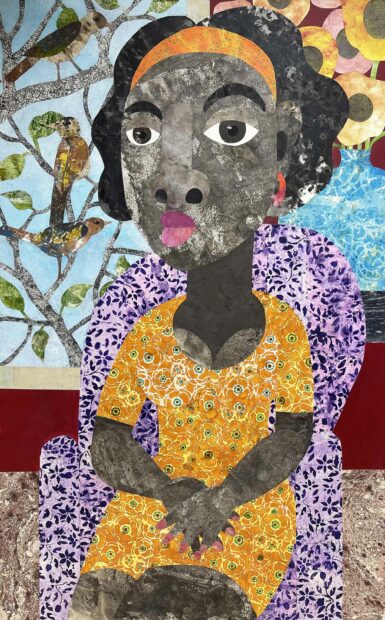
Evita Tezeno, “Cherish the Moment,” 2022, collage painting, 48 x 30 inches. Collection of Sheryl Adkins-Green and Geoff Green, Dallas, TX
I recently met Dallas-based artist Evita Tezeno at the Dallas Art Fair, where her work was prominently on display in the booth of L.A. gallery Luis De Jesus. Like her work, the artist is warm, welcoming, full of life. I am happy to note that her work is finally getting the attention it deserves, and she has a solo show at the Houston Museum of African American Culture.
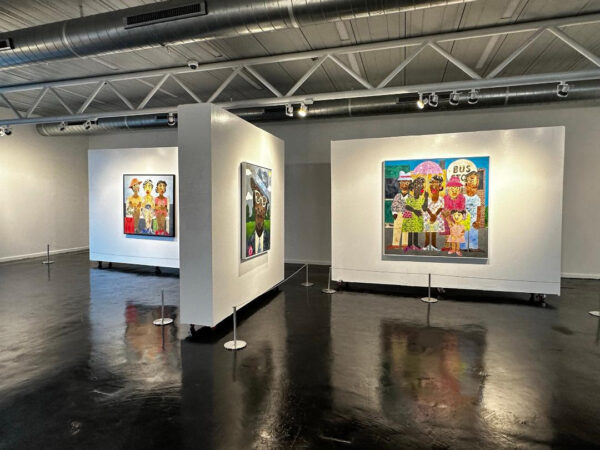
Installation view of “Evita Tezeno: Out of Many,” on view at the Houston Museum of African American Culture
Her collage paintings depict scenes of American Black life, inspired by friends, families, childhood memories, and dreams. Her use of pattern, design and the flattening of pictorial space in the composition, combined with powerful, memorable characters, produces magical worlds full of joy and wonder. Tezeno uses intricately patterned, hand-painted paper to fold additional layered references and meaning into the work.
It was difficult to narrow down which works to write about, since they are all so compelling. I found myself returning again and again to the paintings featuring a single female character. In Cherish the Moment (2022), a seated figure looks directly at the viewer. Her body language is comfortable, yet her face is stern. She seems more resigned to the moment, rather than enjoying it. Behind her is a window with birds perched on branches curiously leaning into the figure, as if they are about to tell her a secret or sing into her ear. This is an interesting choice of framing, since the figure is ignoring the natural scene behind her. The flattened pictorial frame dissolves the boundary between the interior and exterior spaces. I am also drawn to the vase of flowers behind the chair, whose scale matches that of the birds and branches. The pattern in the woman’s dress mimics that of the flowers. The lilac chair also features a detailed flower pattern. The pattern in the lower part of the painting, presumably the floor of the domestic space, resembles rock. The conflation of both interior/exterior space and the multiple references to nature within the domestic space speak to a balance between humanity and nature.

Evita Tezeno, “She Sits Silently and Watches the World Around Her,” 2021, mixed media collage on canvas, 48 x 36 inches, 49 x 37 x 1.5 inches framed. Collection of Jay Wingate and Luis De Jesus, Los Angeles, CA. Courtesy of the artist and Luis De Jesus, Los Angeles
The interweaving of human and nature is again explored in She Sits Silently and Watches the World Around Her (2021). A standing female figure gazes directly at the viewer with a thoughtful, resigned expression. She is outside in a barren landscape, where the ground is brown; the trees are bare. The woman is holding a large, brilliant pink rose and has three small red flowers in her hair. The blooms sharply contrast the desolate landscape in which she resides. My eyes immediately go to her bright yellow earrings, which serve as beacons of light. The woman’s dress features a recurring concentric spiral, a shape often repeated in natural forms, which symbolizes the cycle of life and a promise of rebirth and transformation. She strikes me as a silent witness to the environmental pollution and destruction that is destroying the natural world. Yet, the blooms promise hope for the future.
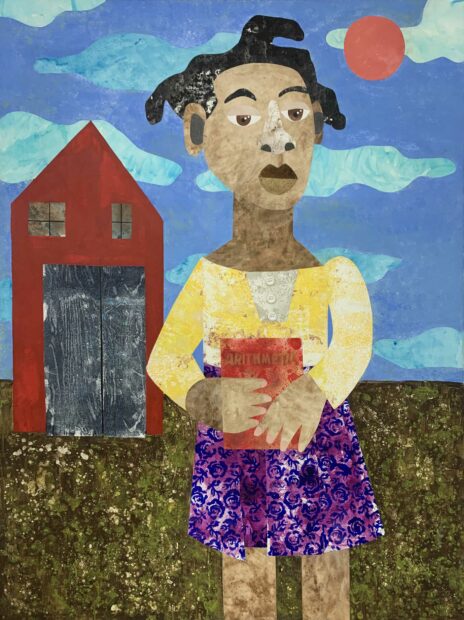
Evita Tezeno, “First Day at My New School,” 2021, from the series “My Life, My Story,” mixed media collage and acrylic on canvas 48 x 36 in, 49.25 x 37.25 in framed. Collection of Laurie Raskin and Rick Shuman, Encino, CA. Courtesy of the artist and Luis De Jesus, Los Angeles
The work First Day at My New School (2022) reminds me of childhood and the conflicting emotions of excitement and anxiety that a new school year brings. The young figure is a dominant force on canvas, dwarfing the little red schoolhouse. She wears a confident expression and proudly displays her math book, which is the same color as the school building. I am drawn to the beautiful layering and swirls of acrylic wash in her skin. The cut-outs of the clouds against a blue sky and the simple shape of the schoolhouse add childlike whimsy to the work. Yet, the overall tone is one of self-assuredness and strength.
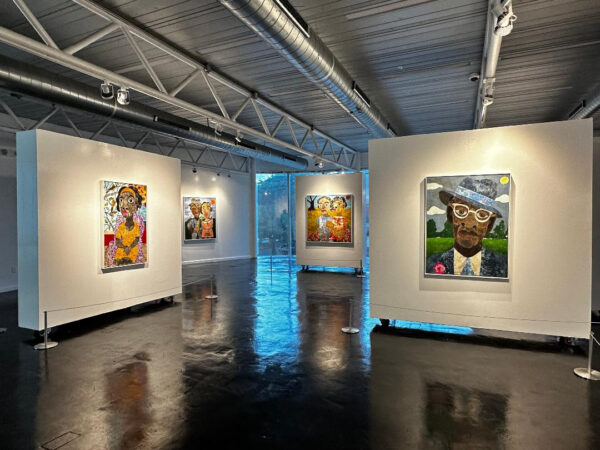
Installation view of “Evita Tezeno: Out of Many,” on view at the Houston Museum of African American Culture
Tezeno’s style is described as contemporary folk-art. I typically think of folk artists as artists who haven’t been formally trained. However, according to the Museum of International Folk Art, this is not necessarily the case. And it is certainly not the case with Tezeno. A few aspects of folk art do relate to the artist’s work — a reflection of shared cultural aesthetics and social issues, as well as the inclusive spirit of art made by and for the people.
Pipilotti Rist: Pixel Forest and Worry Will Vanish is on view at the Museum of Fine Arts Houston through September 4, 2023.
Evita Tezeno: Out of Many is on view at the Houston Museum of African American Culture through June 17, 2023.


